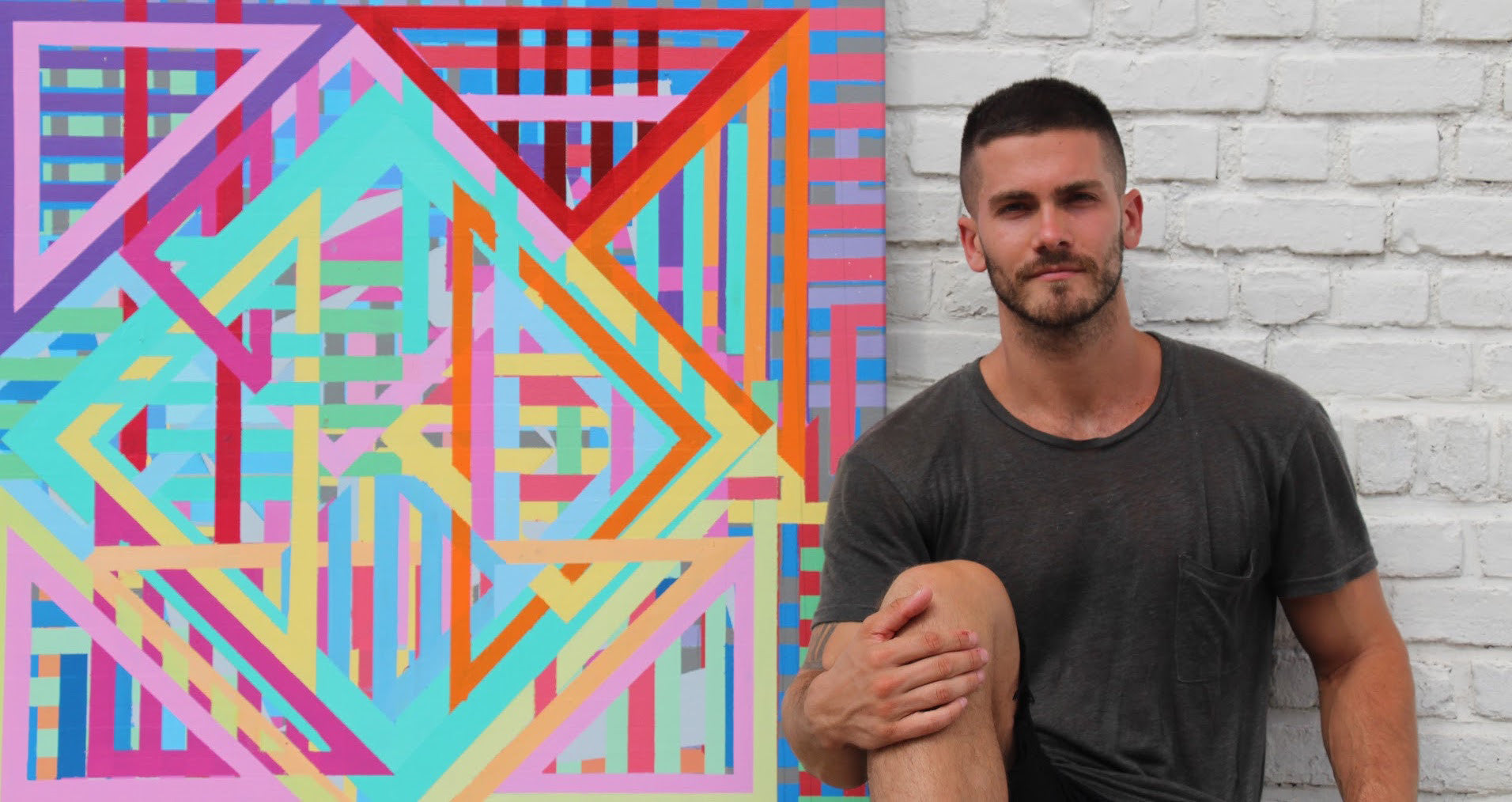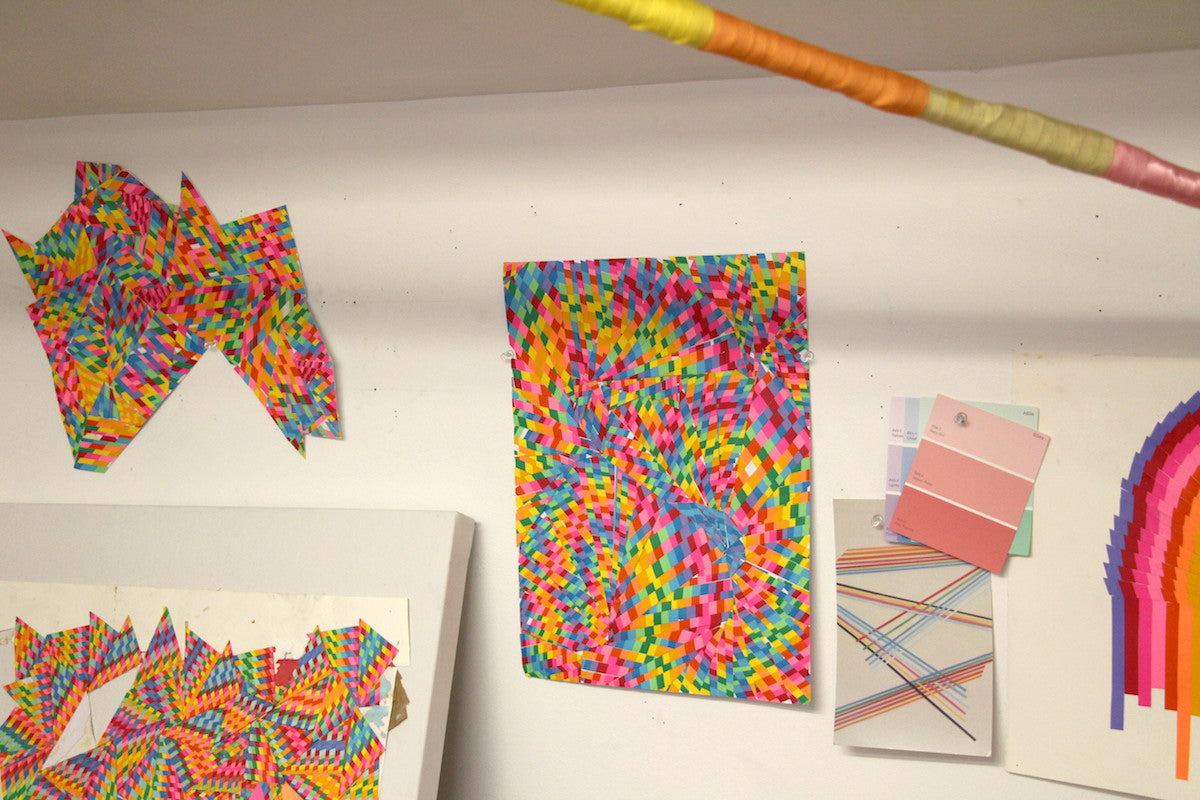Erin: What are you curious about?
Edward: Being that I am an existentialist and naturalist, I am curiously questioning and observing our existence and the way we perceive ourselves. I tend to think of myself as a ravenous human with a wild heart, always on a constant exploration, like that of a child. I find myself fantasizing about the universe and all the kinetic energy and fibers that travel through space, through people, and through ideas. My work often times relate to the ideologies (to name a few) of:
Atoms, micro and macro particles, fibers, pixels, infinity, cosmos,what is time?,What is space?,Immortality.
Erin: Describe your work and describe your process.
Edward: At once composed and formless, I owe an obvious debt to the Fauvists’ supremacy of color over form, an aesthetic approach in harmony, or is it tension, within my structurally informed compositions.
My background in architecture is evident in my compositions. Their controlled fluidity is an intentional effort to create something at once structured and formless, but also allowing the process to happen by chance. My works are about the fragmentation of form collapsing in time and space.
The result is a poetic meditation on the fluid nature of reality and the structures imposed to define it. My intent is to allow my work to act as a vessel to receive a conscious awareness of these subconscious events of daily life, which embodies one’s abnormal physical and psychological stages.
Erin: Having worked with crayons, cut paper, yarn, paint and now wood and metal, how do you choose your materials?
Edward: Based on my experimental qualities, I choose how the material and its physical presence can rely on another material to do something peculiar and sometimes obscure, to create a language of it’s own, but also helping me to constantly evolve with my work.
Erin: You dove headfirst into murals for corporate clients. How has working in this large scale changed your process?
Edward: Working large scale at first frightened me, but I knew I had the skill set to do so relating back to my architectural days in school. It really challenged my senses and created a myriad of questions. I strongly believe that as humans we are accustomed to growth and knowledge particularly through challenges. I now find myself exploring with scales and proportions in all my works now, moving from micro to macro every step of the way.
Erin: You have a pretty gut wrenching story about an art show in Berlin. Mind telling us about it?
Edward: Fall 2013 I joined a pop-up exhibition in Berlin with a particular unnamed curator. I had a group show up for a month and I resided in Berlin during that month. Once the show ended the curator fled the gallery within a couple of days of de-installation, taking all works, by all artist included in the show (5 of mine included) and never to be reached or heard of again. For months thereafter I coordinated with the other artist in the show to retrieve the works from the gallerist but ended up largely unsuccessful. Two years later, I still have no idea where those five large to medium scale works ended up but that is something I had to challenge myself to move on from.
Erin: Why did you choose art over architecture?
Edward: I didn’t necessarily choose one over the other. I made a conscious decision towards the one that made me happiest, and which one took off first. My art career was doing fairly well at Sibley Gallery in New Orleans (my first representation). Three years later here in New York, after discovering my identity in New Orleans, I find myself slowly merging the gap between my earlier works on canvas to the architectural nuances within my installations and sculptures.
Erin: Where do you pull your inspiration from?
Edward: I am a self-proclaimed “sponge of information”. By this I mean letting everything I encounter serve as an inspiration in my work. Architectural objects become visual references, encounters with people commence new ideas, and listening serves as a means of absorbing chaos and relaying that back as a visual resource. Honestly, personal liberation is the most important methodology for inspiration, getting lost is the only way to find myself, just as working is the only way to learn.
Erin: If you could collaborate with anyone dead or alive who would it be with and what would it look like?
Edward: Jim Lambie, James Turrell, or Vaserely. These three artist are the biggest inspiration for the type of work I do.
Erin: If you had one superpower what would it be?
Edward: There are many that I wish I possessed, but if I had to choose, I would lean towards the ability to see into the 4th Dimension, or as classified, all 12 dimensions of life.
Erin: You work in Brooklyn Art Space among many other artists. How important is surrounding yourself with creatives to your practice?
Edward: Working in a creative environment such as an art collective like BAS with other artist gives me the energy and thriving force to evolve and generate new ideas. As I said previously, “encounters with people commence new ideas”. This has held true for the full two years I have been at the Brooklyn Art Space.
Erin: What's next?
Edward: Working with Fiercely Curious, working on a shoe concept for ICONOfly, Gowanus Open Studios in October, working on an installation for a show titled “Rabbit Hole” in Berlin in December at Berlin Stadtbad Oderberger, and many other projects that will commence as time goes on this fall/winter.







